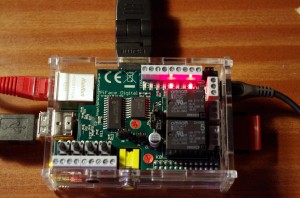Since I first wrote about the PiFace back in July there has been a new development! Dr. Andrew Robinson who’s the leader behind the project at Manchester university have had some valuable feedback from their initial prototype release and re-designed the board and it’s now a full production product complete with all the regulatory markings, using surface mount technology with many improvements too!
The biggest change (for me!) is jumpers to enable (or disable) the two on-board relays. Now you can have full control of all 8 outputs without having the relays click when you are using the outputs for purposes other than the relays.
There is a nice terminal block with the Pi’s 5 volt supply exposed on a screw terminal to use for your external projects too. Still the same 4 buttons which shadow 4 of the 8 inputs.
Another nicety is the addition of a rubber bumper which sits on-top of the Pi’s HDMI socket and prevents the board moving with the possibility of shorting anything out.
Finally, rather than the 4 little 3mm LEDs on the original one, there is now a bank of 8 surface mount LEDs on the 8 outputs! So you can see exactly which output is on or off.
Software wise, it’s the same as before – SPI interface to the Pi and my existing wiringPiFace test program worked out of the box without any changes.
The new PiFace board – note the 2 LEDs lit up – outputs 0 and 3 are on:
(Ok, So I can’t actually access the terminals in the Adafruit case, but it was easier for this quick test to leave the Pi in that case!)
So all in all, it’s a fantastic update to the original, and if you want more information on it, then go to their website here.
Minor update – 23rd October
Andrew informs me that it’s going to be a couple of weeks before they’re ready with the full documentation for the board, so hang in there, but keep checking their site for updates!


This is great news. Any word on when/where it will be available and potential cost?
Keep an eye on their own website:
-Gordon
Mr. Gordon.
Congratulations.
Well done.
Regards,
Luiz Almeida.
Hi,
they do not seem to offer the mk2 for sale on their website ( http://shop.openlx.org.uk/ ) could you tell us where did you get yours?
I was sent it directly so I could have a quick look and review of it. I’m sure they’ll be avalable soon.
-Gordon
Hi Gordon – can’t see any info on new board on their site 🙁 – do you have a direct link I can use?
Simon
No direct link I’m afraid – well, it is a university project after all – I’m sure they’ll update their own site soon!
-Gordon
Will the board have support for 1-wire sensors?
The PiFace does not have support for 1-wire sensors.
-Gordon
Hi Gordon I’m trying to make a twitter chickhen as my first project but not having much luck with the twitter code that you can download from the piface site could you help?
All my code for the PiFace is written in C and not Python which I think the piface people are advocating, so I’m not sure I can help you I’m afraid.
I don’t even know where to download their code at all.
The only thing I can suggest is to test it with my code just to make sure you have the basic thing working, then try their code again.
-Gordon